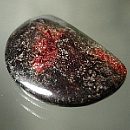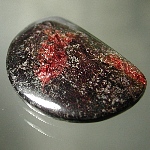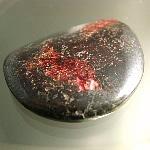|
ClassicGems.net |
|
|
 |
|
Alurgite (a variety of Muscovite) |
|
|
Discovered in 1865; IMA status: Not Valid (a variety of Muscovite) |
|||
|
|
|
Chemistry |
|
|
|
|
|
K2(Mg,Al)4-5(Al,Si)8O20(OH)4 (Muscovite) |
|
|
|
Potassium Magnesium Aluminum Silicate Hydroxide |
|
|
|
|
More Information |
|
|
|
|
|
|
Alurgite
is a variety of Muscovite. |
|
|
Mindat.org
(Alurgite) |
|
View mineral photos: |
|
|
|
|
|
Alurgite is a manganoan variety of Muscovite that was originally described in 1865 by J.F.H. Breithaupt who also named the mineral. The name Alurgite is from the Greek word halourges meaning genuine purple dye from the sea in allusion to its typical reddish-purple color. In ancient Greece Murex shells from the sea were used to produce a purple dye called halourges which was the most expensive dye known in antiquity. Alurgite cabochon gems are uncommon but beautiful with the reddish-purple color against a dark background of black Braunite. Alurgite is a reddish-purple variety of Muscovite that gets its color from the presence of manganese in its chemical formula. A green variety of Muscovite also exists that is called Fuchsite and is colored by the presence of chromium. W. T. Schaller (1959) placed Alurgite as an intermediate between Leucophyllite (now a synonym of Aluminoceladonite) and Muscovite. Alurgite is named from the Greek word halourges meaning genuine purple dye from the sea in allusion to its typical reddish-purple color. In ancient Greece Murex shells from the sea were used to produce a purple dye called halourges which was the most expensive dye known in antiquity. Distribution: Ouro Preto, Minas Gerais, Brazil; Prabornaz Mine, Saint-Marcel, Aosta Valley, Italy; Tone mine, Kinkai-Tone-machi, Nagasaki City, Nagasaki Prefecture, Kyushu Region, Japan. |
|
|
Alurgite gems for sale:
|
|||||||||||||||||||||||||||

